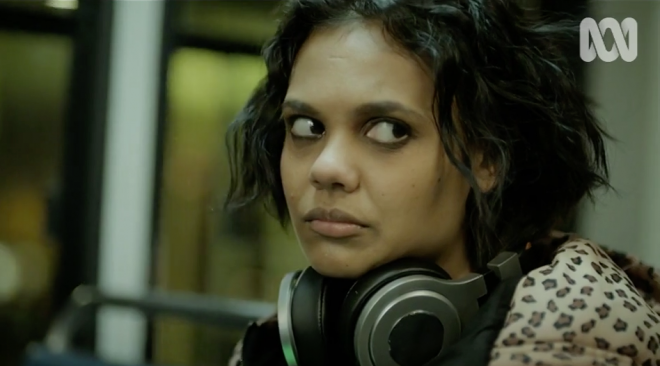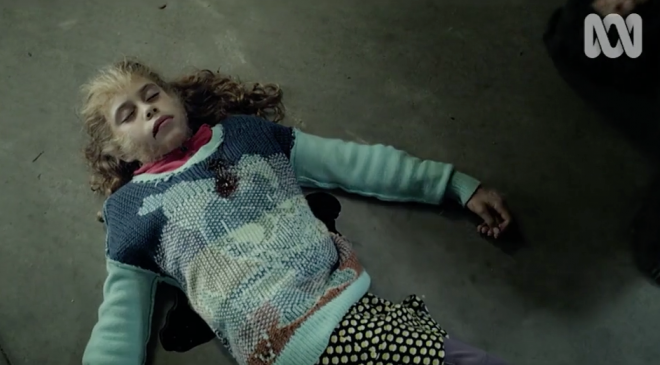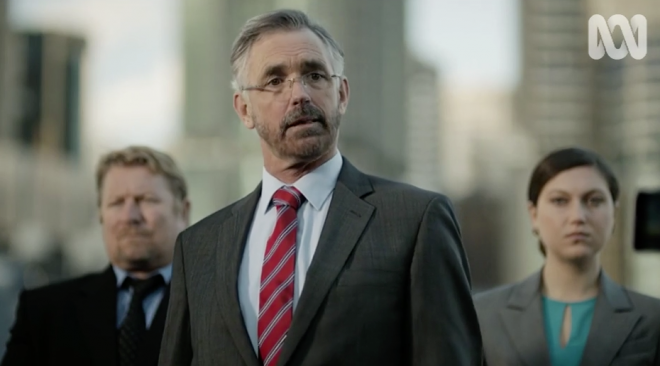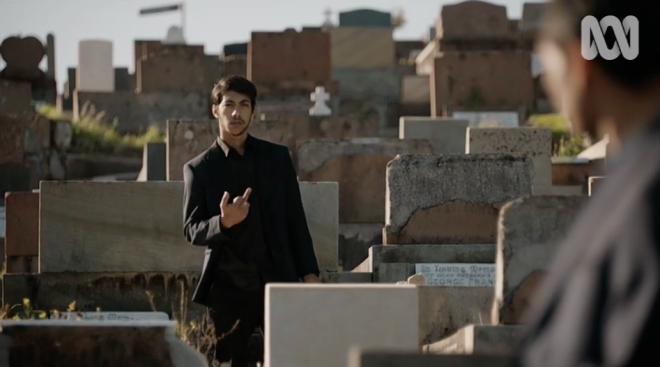‘Cleverman’ Recap: This Is The Show Australia Has Been Waiting For
We have so much to talk about.

The first episode of Cleverman — possibly the most highly-anticipated Australian TV show of the year — starts with a familiar scene. A few drunk young dickheads, arguing over which bars might still be open, tumble onto a bus and quickly spot a pretty girl (Miranda Tapsell) whose attention they can demand. They slide off her headphones, swipe her book and toss it to one another like schoolboys; as everything quickly descends into standard threatening not-quite-jokes, she remains immune to their ‘charms’.
The audience barely has time to worry which way this might go before it’s made clear she can take care of herself. She pushes up her sleeve to reveal thick, coarse arm hair, and the fear in the boys’ eyes is more than the usual terror of female body fuzz. Despite their cries for the driver to stop and detain her, she clears a path through them and off the bus, hurling the instigator down the aisle like Buffy throwing a vamp across Sunnydale cemetery and disappearing into the night.
–
Welcome To Cleverman
The Hairypeople (based, like the Cleverman role and the Namorrodor monster, on Dreaming stories) are a race of indigenous Australian beings who live for at least 200 years. While some “shave down” to pass in society, others pride themselves on their pelts. The Hairy effects were created by Weta Workshop and the facial hair is fascinating in its intricacy and variety, although the body hair looks a little Teen Wolf cheesy considering Weta’s pedigree.
The Hairies lifespan is worth noting — assuming the nation’s history is the same, some adult Hairypeople would have seen basically the entire history of white occupation of Australia. But they’ve only recently revealed themselves to wider Australian society, and their physical strength and other-ness (they’re significantly different to humans on a genetic level) has seen them labelled “sub-humans” or “subbies” and heavily policed by a government agency called the Containment Authority (CA). They’re now separated from “normal” society and rounded up in a sort of ghetto (The Zone) — an area based around an abandoned railway station that seems to be tolerable for humans but is “a refugee camp for Hairies”.
Some Hairy families pay smugglers to get them out of here, and our human anti-hero, Koen (Hunter Page-Lochard) is one such entrepreneur. He appears to be a friendly face as he and his mate/business partner Blair (Ryan Corr) whisk a family away to a safe house in the City, but they take the family’s money and promptly dob them in to the CA for an extra reward. Koen is a cynic and his moral relativism is still intact despite Blair’s guilt when the CA shoot the family’s youngest daughter dead during the raid.
This is just one thread of the story. There’s also Koen’s estranged half-brother, Waruu (Rob Collins), an upstanding but torn community leader inside the Zone who’s banging Carly Bishop Belinda Frosche (Leeanna Walsmann) behind his wife’s back. Frosche is the reporter who covered the CA raid for ambiguously villainous Channel 8 mogul Jarrod Slade (Iain Glen) and Slade’s wife Charlotte Cleary (Frances O’Connor) is a doctor who works with Waruu in the Zone. Slade has some kind of nefarious arrangement with Waruu and Koen’s Uncle Jimmy (national treasure, Jack Charles) who appears to be trading his spiritual powers as “Cleverman” for money and can also bring dead people back to life and call down monsters to bring about his own violent death. Look, it’s a lot.
Like the first issue of any comic book or sci-fi show, Cleverman’s first episode has a lot of table-setting. But the show isn’t just trying to tell the Aboriginal superhero story creator Ryan Griffen wanted his son to grow up with, or a sci-fi story with cool fights. These genres have been used to explore social issues for as long as they’ve been around, and their usual themes — what it means to have power(s), to be different, to ignore or accept duty, and to be human — have a natural resonance when it comes to civil rights and racial politics.
–
Australia And On-Screen “Dystopia”
The cleverest thing about this show might be how it subtly relocates real divisions in Australian society into a fictional world while still keeping Aboriginal faces and voices at the centre. There is still, as in our reality, an ongoing tension between the Indigenous and non-Indigenous communities — the authority figures outside the Zone appear to be exclusively non-Indigenous, and most of the Indigenous characters we meet in this first episode appear to live in the Zone.
Though Koen grew up in the Zone himself, he is disconnected from his background and culture and is in many ways privileged and prejudiced at the beginning of this episode. He mispronounces Boondee’s name as “Bundy”, seems a little uncomfortable when the Hairy family speak in language (Gumbaynggirr, spoken in parts of the NSW coast), and uses the same argument many Australians use about asylum seekers when he justifies turning in the family: they’ve got a roof over their heads and they’re fed, what have they got to complain about? It’s interesting to see him and his brother Waruu be complicit, in different ways, in the oppression of an indigenous race.
The way that racial and class hierarchies are made more explicit in this version of Australia neatly underscores how real-life Australian culture insists on othering Aboriginal people as well as asylum seekers, Muslims, and whoever else someone has decided is threatening to their hold on power.
Australia might not make people exit poorer areas through militarised checkpoints, but we’re not exactly making it easy for people under a certain income level to live in certain areas. Australia might not be branding asylum seekers’ necks as we shuffle them into camps (we’re not, right? Are we sure we’re not doing that?), but we’re definitely keeping them locked up somewhere shitty for craven, tenuous reasons and dehumanising them in the press. Australian politicians might not be publicly calling Indigenous people “subhumans”, but the nation certainly has a history of dehumanising them, denying them agency, and making it inexplicably hard for them to get cabs.
We might not have a hyper-militarised Containment Authority with a drunk swastika for a logo, but we’ve got an unnecessarily militarised Border Force with a shady faceless crocodile for a logo.
It’s hard not to wonder if this blunt approach to paralleling and extrapolating real-life politics will be a little lost on American viewers unfamiliar with the particular strains of racism still present in Australian society and institutions. But then again, who says they won’t relate to plots about authorities shooting innocent members of habitually dehumanised and marginalised groups, and walls being built to keep supposedly undesirable types away?
–
It’s All In The Details
Cleverman is also Australian in ways that realist dramas less concerned with atmospherics often miss. Lit-up cranes bristle on the horizon in the background of so many of the exterior shots, evoking that specific feeling of living in Sydney where things are always being built solely for the benefit of people with more money, privilege and influence than you. A tight roll of cash hits a tabletop with the solid clack of laundry-proof polymer currency, not the soft Hollywood thud of greenbacks. Guns are an afterthought for the young crooks, not a given, and are just as quickly dismissed as more trouble than they’re worth.
The details of the near-future setting are mostly subtly done too. The Sydney bus has a more detailed route info panel and Tapsell’s well-worn book has e-ink pages in the cold open. Some things, like the gesture-based interface at the Containment Authority, are a bit overdone both from a genre standpoint and also in the context of the show’s version of our current reality. (The CA may be well-funded, but they’re still a government agency — I mean, have you tried logging into MyGov lately?) The semi-dystopian elements are mostly based in government policies and tools not far at all from where we are now: surveillance drones, personal ID codes, a well-established system of rewards for dobbing, highly militarised police, government embargoes on media coverage of treatment of certain groups…
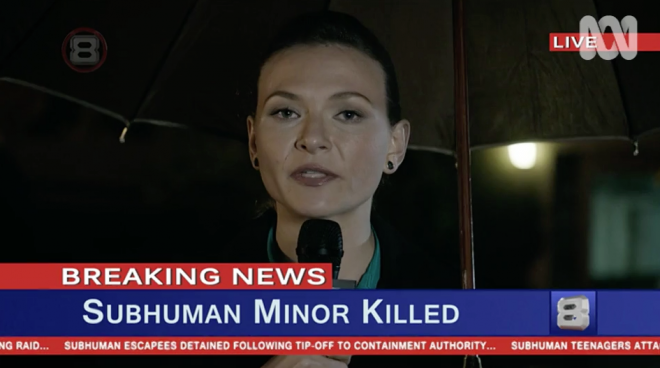
It’s all horribly familiar.
There are, however, larger moments in the show which needed work. The sex scenes, while appreciated, feel a bit like they weren’t quite thought through (do Waruu and Belinda make a habit of fucking with narratively relevant conservative talkback radio on in the background? When Koen faints in the middle of his kegroom quickie, does she somehow tuck his junk back into his jocks and do his jeans up off-screen before Blair gets in there?) There are also instances of stilted dialogue or secondary characters thinly sketched. But it’s not unusual for sci-fi and fantasy shows to somewhat prioritise world-building over zippy, natural dialogue and neatly episodic structure. It’s a rare genre show that lays all its plot threads out clearly in the first episode, sometimes choosing clunky exposition over letting important points go unexplained.
It looks like this will have a great payoff. The “superhero” element — namely, Koen’s journey from bitter, amoral black sheep to reluctantly becoming a leader in the fight against an evil creature (and, one presumes, against crippling social disunity) — is certainly set up as a strong origin story.
We don’t entirely know yet what the show’s conception of the Cleverman skillset is, but the reveal of Koen’s newly acquired healing power is superb: the horror of realising his finger has been torn right off by Waruu’s Hairyman mate, the hilarious way Ash takes Koen’s literal screams of “he’s torn it off!” as exaggeration while the rip repairs itself, the unblemished palm revealed under the tap seconds later, and the neat visual effect of the deliberate, deep cut healing itself in seconds. It’s a fun, gory sequence with a childishly satisfying payoff at the burial, as Koen looks down over his sunnies just enough to show Waruu his Cleverman eye, and flips him that smartarse finger.
He’s the borderline-evil dickhead Loki to Waruu’s nobler-than-thou Thor, and the brothers’ arc is clearly set out. Koen will have to rise to be worthy of his new identity, and Waruu (already a bit corrupted, with his extramarital affair) is heading for a fall if he can’t deal with not being Uncle Jimmy’s true successor.
The fact that there’s so much of this to dive into after just one episode is a testament not only to how unexpectedly smart this premise is, but how much of it hasn’t already been said and explored in a genre context before. This kind of show was long overdue on Australian TV, and with a second season ordered before the first had even aired, creator Ryan Griffen and his team have even more space to spin this story out.
–
Cleverman is on ABC1 at 9.30pm Thursday nights.
–
Caitlin Welsh is a freelance writer who tweets from @caitlin_welsh.


